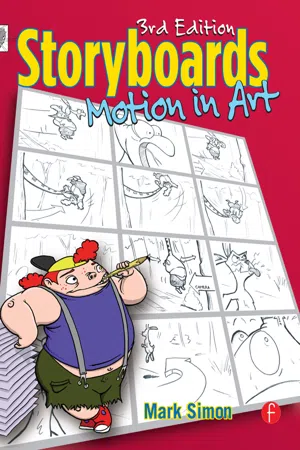
- 448 pages
- English
- ePUB (mobile friendly)
- Available on iOS & Android
eBook - ePub
Storyboards: Motion In Art
About this book
Among the most useful tools in the production of any TV show or film is the storyboard, which is the visual blueprint of a project before it is shot. The director's vision is illustrated in the manner of a comic strip and handed on to the crew for purposes of budgeting, design, and communication.
Storyboards: Motion in Art 3/e is an in depth look at the production and business of storyboards. Using exercises, real-life examples of working in the entertainment industry, interviews with people in the industry, and sample storyboard drawing, this book will teach you how to :
* Develop and Improve your boards
* Work with directors
* Develop your resume and your portfolio
* Market your talent
* Create and improve a storyboard using computers
Packed full of practical industry information and examples, this book will help the reader improve their skills to either land their first assignment or advance their career.
Frequently asked questions
Yes, you can cancel anytime from the Subscription tab in your account settings on the Perlego website. Your subscription will stay active until the end of your current billing period. Learn how to cancel your subscription.
At the moment all of our mobile-responsive ePub books are available to download via the app. Most of our PDFs are also available to download and we're working on making the final remaining ones downloadable now. Learn more here.
Perlego offers two plans: Essential and Complete
- Essential is ideal for learners and professionals who enjoy exploring a wide range of subjects. Access the Essential Library with 800,000+ trusted titles and best-sellers across business, personal growth, and the humanities. Includes unlimited reading time and Standard Read Aloud voice.
- Complete: Perfect for advanced learners and researchers needing full, unrestricted access. Unlock 1.4M+ books across hundreds of subjects, including academic and specialized titles. The Complete Plan also includes advanced features like Premium Read Aloud and Research Assistant.
We are an online textbook subscription service, where you can get access to an entire online library for less than the price of a single book per month. With over 1 million books across 1000+ topics, we’ve got you covered! Learn more here.
Look out for the read-aloud symbol on your next book to see if you can listen to it. The read-aloud tool reads text aloud for you, highlighting the text as it is being read. You can pause it, speed it up and slow it down. Learn more here.
Yes! You can use the Perlego app on both iOS or Android devices to read anytime, anywhere — even offline. Perfect for commutes or when you’re on the go.
Please note we cannot support devices running on iOS 13 and Android 7 or earlier. Learn more about using the app.
Please note we cannot support devices running on iOS 13 and Android 7 or earlier. Learn more about using the app.
Yes, you can access Storyboards: Motion In Art by Mark Simon,Mark A. Simon in PDF and/or ePUB format, as well as other popular books in Computer Science & Digital Media. We have over one million books available in our catalogue for you to explore.
Information
PART ONE
GETTING STARTED
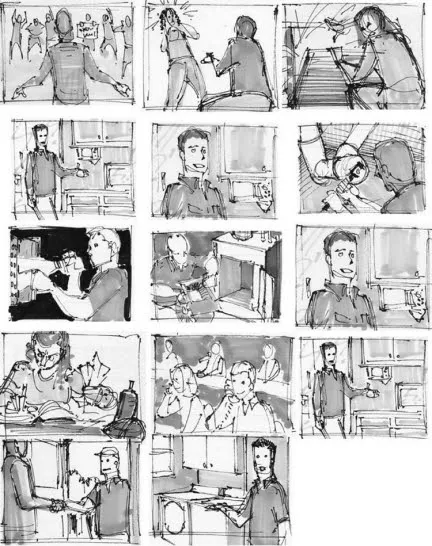
Thumbnail storyboards by Dan Antkowiak of Animatics & Storyboards, Inc.
CHAPTER 2
Getting Started
The knowledge of storyboarding is important for everyone in production who has to communicate and understand visuals. You do not have to be able to draw well to produce functional storyboards, although lacking such ability will limit your chances of making a career out of it. A director sketching quick boards for the DP (director of photography) does not need quality art to get the point across. Production people simply need to be able to read storyboards to understand and make use of this great production resource.
If you are interested in pursuing storyboarding as a career, the first step in becoming a storyboard artist is understanding what storyboards are and how a storyboard artist works. Since you are reading this book, you’re taking the right first step. As important as it is to have the ability to draw, it’s not the most important aspect of storyboarding. Storyboards with bad art can still be good storyboards, but storyboards without the story are just art, not storyboards. Even great artists tend to produce poor art at times when the production deadlines are too short. As Tim Burgard, storyboard artist on The Day After Tomorrow and Scorpion King, says, “There are a lot of successful storyboard artists out there who are just strong story people, and they get their message across, but they aren’t necessarily the strongest draftsmen out there. So I would say that understanding story and understanding camera are the main things for a storyboard artist to know.”
Larry Latham, animation director and teacher at Walt Disney TV Animation, agrees: “I have held many beautifully rendered boards in my hands that were, from a production standpoint, totally unusable. And I have seen, in moments of deadline panic, fantastic, expressive, workable boards done with stick figures. In animation, gesture and expression are far more important than beautiful technique” (AWN, July 15, 2004, by Larry Latham).
To pursue storyboarding as a career, you also need to learn about directing and editing, and you need to learn to sketch the human form quickly. Some directors got their start as storyboard artists, such as Alfred Hitchcock, Joe Johnston (who directed Jurassic Park 3, Hidalgo, The Rocketeer, Jumanji, Honey I Shrunk The Kids), and others. You will be called on to help solve content problems, flesh out action sequences, and direct scenes on your boards as well as fill out the director’s vision.
Next, you will need to be able to draw. There are many great books and classes that can teach you how to draw. I’ll show you some helpful hints for the drawing process that relate specifically to storyboarding, but I’ll leave the intensive illustration instruction to others. This book, however, will teach you how to be a better, and more successful, storyboard artist.
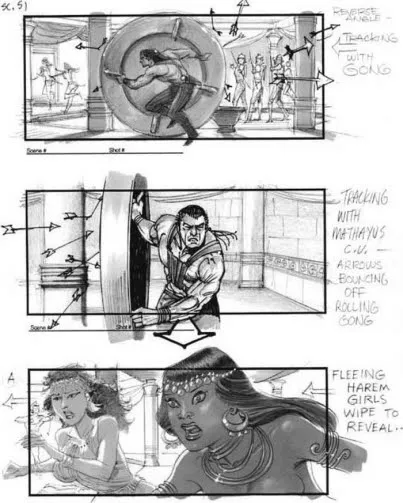
Figure 2.1 Scorpion King storyboards by Tim Burgard. (Courtesy of Universal Studios Licensing LLLP.)
During your search for that elusive first job, you will need to send out résumés and prepare a portfolio for any meetings. Of course to send out résumés, you need to know who to contact for work. Once you find out who to contact, you need to know what those prospective employers will want to see. One source of the answers to these questions is this book.
Another source of information about storyboards is your local professional storyboard artist. Most artists are more than willing to talk with other artists, so it never hurts to ask. The easiest way to find storyboard artists is to ask around in your local film community, or look in the local production directory, which can be found at the chamber of commerce or film commission for your area.
It is important to understand some basic production and storyboard terminology. We break the script into scenes during preproduction. Scenes are sequences that take place in one location at one point in time. If a character moves from inside to outside his house, scene 1 is inside and scene 2 is outside. If while inside, he has a
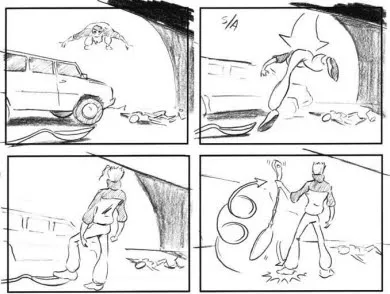
Figure 2.2 One action is shown with four frames. Spoonman storyboards by Mark Simon of Animatics & Storyboards, Inc. (Images courtesy of The DAVE School.)
flashback of what happened the night before in the same room, that is also considered a different scene. Shots are the different camera angles used to shoot each scene. If the scene inside his living room is shot with a wide establishing shot, a close-up, and a two shot of the actor and his girlfriend, then the scene consisted of three shots. Panels are the individual drawings or frames. Each shot may consist of any number of panels. Long and action-oriented shots may need many panels to illustrate the action.
For those of you who are experienced storyboard artists, it’s never too late to get started on improving both your boards and your professionalism. If you get just one good idea from this book, it will have been worth it. For those of you just getting started in storyboarding, read on, enjoy, and draw, draw, draw.
CHAPTER 3
What It Takes to Be a Storyboard Artist
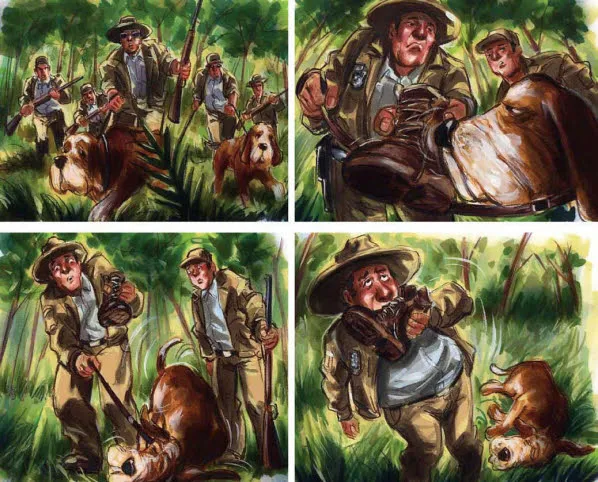
Figure 3.1 Storyboards by German artist Ovi Hondru.
The ability to draw is the most obvious talent needed to became a successful storyboard artist. But just being able to draw well, does not make someone a good storyboard artist. Storyboard artists are visual storytellers. They have to be able to understand directing and editing (see Chapter 21, Directing Shots). They have to know the differences between a long lens (a zoom, or telephoto, lens) and a short lens (wide-angle lens). They have to understand how to work with directors and translate the director’s vision to the rest of the crew (see Chapter 22, Working with Directors). They need to know production terminology such as pan, crane, tilt, dolly, track, close-up, long shot, and establishing shot (see Chapter 21, Directing Shots, among others).
Storyboard artists need to understand when and why to use special camera shots. What motivates those shots (see Chapter 24, Staging and Composition)? What makes a scene funny? What makes it scary? How do you make an audience believe a character is a giant? How do you make them believe a character is only 6 inches tall (see Chapter 24, Staging and Composition)? Storyboard artists also have to understand screen direction and line of action (see Chapter 23, Screen Direction).
Understanding storyboards is important in order to work in a production environment. It’s especially important if you have to sketch out some boards to describe something to someone. Not everyone wants to storyboard professionally for a career, but many people in live action and animation will need to draw boards at some point during a production.
For those who do wish to storyboard for their career, it can be a lot of fun. It is also a lot of work and consists of weird hours. In addition to the preceding items, to be a professional storyboard artist you have to:
- Have storyboard samples, not just sample illustrations. There is a difference.
- Be able to sketch quickly and accurately.
- Properly and quickly sketch perspective.
- Be able to draw anything from any angle (although you can use references).
- Match cartoon styles to storyboard in animation (see Chapter 13, Animation Boards).
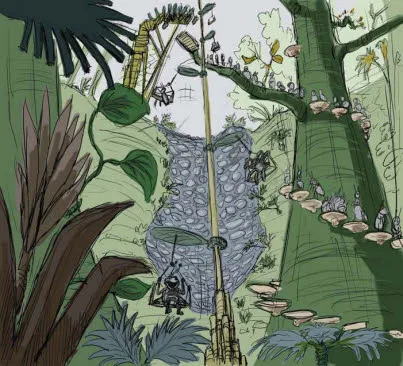
Figure 3.2 The low angle looking up emphasizes the height of the background image. Storyboard layout for Creepers by Travis Blaise of Animatics & Storyboards, Inc. (© 2006, Lyons Entertainment, Inc.)
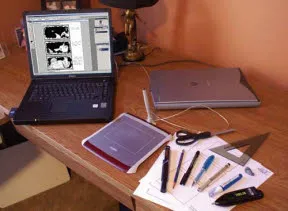
Figure 3.3 Laptop, graphics tablet, scanner, and supplies are needed for some location work.
- Like working in a fast environment.
- Understand you may be turning down excess work one week and searching for work the next. It’s a feast-or-famine industry.
- Storyboard artists need to have the following:
- Access to a high-speed modem.
- A fax mach...
Table of contents
- Cover
- Half Title
- Title Page
- Copyright
- Contents
- Acknowledgments
- Preface
- Introduction
- Part One: Getting Started
- Part Two: The Art of Storyboarding
- Part Three: The Business of Storyboarding
- Part Four: Interviews
- Part Five: Exercises
- Part Six: Experiment
- Part Seven: Appendices
- Part Eight: Storyboard Samples
- Glossary
- Index